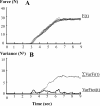Error compensation during finger force production after one- and four-finger voluntarily fatiguing exercise
- PMID: 17443316
- PMCID: PMC2883628
- DOI: 10.1007/s00221-007-0942-z
Error compensation during finger force production after one- and four-finger voluntarily fatiguing exercise
Abstract
The effect of muscle fatigue on error compensation strategies during multi-finger ramp force production tasks was investigated. Thirteen young, healthy subjects were instructed to produce a total force with four fingers of the right hand to accurately match a visually displayed template. The template consisted of a 3-s waiting period, a 3-s ramp force production [from 0 to 30% maximal voluntary contraction (MVC)], and a 3-s constant force production. A series of 12 ramp trials was performed before and after fatigue. Fatigue was induced by a 60-s maximal isometric force production with either the index-finger only or with all four fingers during two separate testing sessions. The average percent of drop was 38.2% in the MVC of the index finger after index-finger fatiguing exercise and 38.3% in the MVC of all fingers after four-finger fatiguing exercise. The ability of individual fingers to compensate for each other's errors in order for the total force to match the preset template was quantified as the error compensation index (ECI), i.e., the ratio of the sum of variances of individual finger forces and the variance of the total force. By comparing pre- and post-fatigue performance during four-finger ramp force production, we observed that the variance of the total force was not significantly changed after one- or four-finger fatiguing exercise. The ECI significantly decreased after four-finger fatiguing exercise, especially during the last second of the ramp; while the ECI remained unchanged after index finger single-finger fatiguing exercise. These results suggest that the central nervous system is able to utilize the abundant degrees of freedom to compensate for partial impairment of the motor apparatus induced by muscle fatigue to maintain the desired performance. However, this ability is significantly decreased when all elements of the motor apparatus are impaired.
Figures






Similar articles
-
Perception of finger forces within the hand after index finger fatiguing exercise.Exp Brain Res. 2007 Sep;182(2):169-77. doi: 10.1007/s00221-007-0978-0. Epub 2007 May 24. Exp Brain Res. 2007. PMID: 17522850 Free PMC article.
-
The effect of a fatiguing exercise by the index finger on single- and multi-finger force production tasks.Exp Brain Res. 2001 Jun;138(3):322-9. doi: 10.1007/s002210100698. Exp Brain Res. 2001. PMID: 11460770 Free PMC article.
-
The effect of fatigue on multifinger co-ordination in force production tasks in humans.J Physiol. 2000 Mar 1;523 Pt 2(Pt 2):523-32. doi: 10.1111/j.1469-7793.2000.00523.x. J Physiol. 2000. PMID: 10699094 Free PMC article.
-
The effect of metabolic alkalosis on central and peripheral mechanisms associated with exercise-induced muscle fatigue in humans.Exp Physiol. 2015 Apr 20;100(5):519-30. doi: 10.1113/EP085054. Exp Physiol. 2015. PMID: 25727892 Review.
-
The cutaneous contribution to adaptive precision grip.Trends Neurosci. 2004 Oct;27(10):637-43. doi: 10.1016/j.tins.2004.08.006. Trends Neurosci. 2004. PMID: 15374677 Review.
Cited by
-
Analysis of increasing and decreasing isometric finger force generation and the possible role of the corticospinal system in this process.Motor Control. 2013 Jul;17(3):221-37. doi: 10.1123/mcj.17.3.221. Epub 2013 Jan 31. Motor Control. 2013. PMID: 23370725 Free PMC article.
-
Fatigue and motor redundancy: adaptive increase in finger force variance in multi-finger tasks.J Neurophysiol. 2010 Jun;103(6):2990-3000. doi: 10.1152/jn.00077.2010. Epub 2010 Mar 31. J Neurophysiol. 2010. PMID: 20357060 Free PMC article.
-
Stabilization of the total force in multi-finger pressing tasks studied with the 'inverse piano' technique.Hum Mov Sci. 2011 Jun;30(3):446-58. doi: 10.1016/j.humov.2010.08.021. Epub 2011 Mar 29. Hum Mov Sci. 2011. PMID: 21450360 Free PMC article.
-
Typing keystroke duration changed after submaximal isometric finger exercises.Eur J Appl Physiol. 2009 Jan;105(1):93-101. doi: 10.1007/s00421-008-0878-4. Epub 2008 Oct 14. Eur J Appl Physiol. 2009. PMID: 18853179 Free PMC article.
-
Perception of finger forces within the hand after index finger fatiguing exercise.Exp Brain Res. 2007 Sep;182(2):169-77. doi: 10.1007/s00221-007-0978-0. Epub 2007 May 24. Exp Brain Res. 2007. PMID: 17522850 Free PMC article.
References
-
- Allen TJ, Proske U. Effect of muscle fatigue on the sense of limb position and movement. Exp Brain Res. 2006;170:30–38. - PubMed
-
- Bernstein NA. The problem of the interrelation of co-ordination and localization. Arch Biol Sci. 1935;38:1–35.
-
- Bernstein NA. The co-ordination and regulation of movements. T. Pergamon Press; Oxford: 1967.
-
- Bigland-Ritchie B, Donovan EF, Roussos CS. Conduction velocity and EMG power spectrum changes in fatigue of sustained maximal efforts. J Appl Physiol. 1981;51:1300–1305. - PubMed
-
- Bonnard M, Sirin AV, Oddsson L, Thorstensson A. Different strategies to compensate for the effects of fatigue revealed by neuromuscular adaptation processes in humans. Neurosci Lett. 1994;166:101–105. - PubMed
Publication types
MeSH terms
Grants and funding
LinkOut - more resources
Full Text Sources

